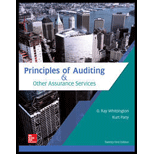
Principles Of Auditing & Other Assurance Services
21st Edition
ISBN: 9781259916984
Author: WHITTINGTON, Ray, Pany, Kurt
Publisher: Mcgraw-hill Education,
expand_more
expand_more
format_list_bulleted
Concept explainers
Question
Chapter 11, Problem 36HOQ
To determine
Identify the transaction that would most likely to be detected by an auditor’s review of the client’s sales cutoff.
Expert Solution & Answer
Want to see the full answer?
Check out a sample textbook solution
Students have asked these similar questions
On May 1, Year 1, Bolt Corp. issued 11% bonds in the face amount of $1,000,000 that mature on May 1, Year 10. The bonds were issued to yield 10%, resulting in a bond premium of $62,000. Bolt uses the effective interest method of amortizing bond premiums. Interest is payable semiannually on November 1 and May 1. What amount should Bolt report as the unamortized bond premium in its October 31, Year 1, balance sheet?
A.
$58,590
B.
$58,900
C.
$60,100
D.
$62,000
Ans
ABC
Chapter 11 Solutions
Principles Of Auditing & Other Assurance Services
Ch. 11 - Explain the difference between a customers order...Ch. 11 - Prob. 2RQCh. 11 - Prob. 3RQCh. 11 - State briefly the objective of the billing...Ch. 11 - Prob. 5RQCh. 11 - Prob. 6RQCh. 11 - Prob. 7RQCh. 11 - Prob. 8RQCh. 11 - Prob. 9RQCh. 11 - Prob. 10RQ
Ch. 11 - Prob. 11RQCh. 11 - Prob. 12RQCh. 11 - Prob. 13RQCh. 11 - Prob. 14RQCh. 11 - Prob. 15RQCh. 11 - Prob. 16RQCh. 11 - Prob. 17RQCh. 11 - Prob. 18RQCh. 11 - Prob. 19RQCh. 11 - Prob. 20RQCh. 11 - Prob. 21RQCh. 11 - Prob. 22RQCh. 11 - Give an example of a type of receivable...Ch. 11 - Prob. 24RQCh. 11 - Prob. 25QRACh. 11 - Prob. 26QRACh. 11 - Prob. 27QRACh. 11 - Prob. 28QRACh. 11 - Prob. 29QRACh. 11 - Prob. 30QRACh. 11 - Prob. 31QRACh. 11 - Prob. 32QRACh. 11 - Prob. 33QRACh. 11 - Prob. 34QRACh. 11 - Prob. 35QRACh. 11 - Prob. 36AOQCh. 11 - Which of the following would provide the most...Ch. 11 - Prob. 36COQCh. 11 - Prob. 36DOQCh. 11 - Prob. 36EOQCh. 11 - Under SEC rules, which of the following is not...Ch. 11 - Prob. 36GOQCh. 11 - Prob. 36HOQCh. 11 - Prob. 36IOQCh. 11 - Prob. 36JOQCh. 11 - Prob. 36KOQCh. 11 - Prob. 36LOQCh. 11 - Prob. 37OQCh. 11 - Prob. 38OQCh. 11 - An auditors working papers include the following...Ch. 11 - Prob. 40OQCh. 11 - Prob. 41OQCh. 11 - Prob. 42OQCh. 11 - Prob. 43OQCh. 11 - Prob. 44PCh. 11 - Prob. 45PCh. 11 - Prob. 46PCh. 11 - Prob. 47PCh. 11 - The July 31, 20X0, general ledger trial balance of...Ch. 11 - Prob. 49ITCCh. 11 - Prob. 50ECCh. 11 - Prob. 51EC
Knowledge Booster
Learn more about
Need a deep-dive on the concept behind this application? Look no further. Learn more about this topic, accounting and related others by exploring similar questions and additional content below.Similar questions
- turnover ratio.arrow_forwardcan you please solve thisarrow_forwardOn October 1, Year 3, Sheyer Corp. declared a scrip dividend of $600,000 and issued promissory notes to its stockholders in lieu of cash. The corporation has sufficient retained earnings. The notes, which were dated October 1, Year 3, had a maturity date of September 30, Year 4 and a 5% interest rate. What is the effect of this scrip dividend on Sheyer's Year 3 retained earnings after all nominal accounts are closed? A. $0 B. $600,000 decrease. C. $607,500 decrease. D. $630,000 decrease.arrow_forward
arrow_back_ios
SEE MORE QUESTIONS
arrow_forward_ios
Recommended textbooks for you
 Auditing: A Risk Based-Approach (MindTap Course L...AccountingISBN:9781337619455Author:Karla M Johnstone, Audrey A. Gramling, Larry E. RittenbergPublisher:Cengage Learning
Auditing: A Risk Based-Approach (MindTap Course L...AccountingISBN:9781337619455Author:Karla M Johnstone, Audrey A. Gramling, Larry E. RittenbergPublisher:Cengage Learning Auditing: A Risk Based-Approach to Conducting a Q...AccountingISBN:9781305080577Author:Karla M Johnstone, Audrey A. Gramling, Larry E. RittenbergPublisher:South-Western College Pub
Auditing: A Risk Based-Approach to Conducting a Q...AccountingISBN:9781305080577Author:Karla M Johnstone, Audrey A. Gramling, Larry E. RittenbergPublisher:South-Western College Pub

Auditing: A Risk Based-Approach (MindTap Course L...
Accounting
ISBN:9781337619455
Author:Karla M Johnstone, Audrey A. Gramling, Larry E. Rittenberg
Publisher:Cengage Learning

Auditing: A Risk Based-Approach to Conducting a Q...
Accounting
ISBN:9781305080577
Author:Karla M Johnstone, Audrey A. Gramling, Larry E. Rittenberg
Publisher:South-Western College Pub